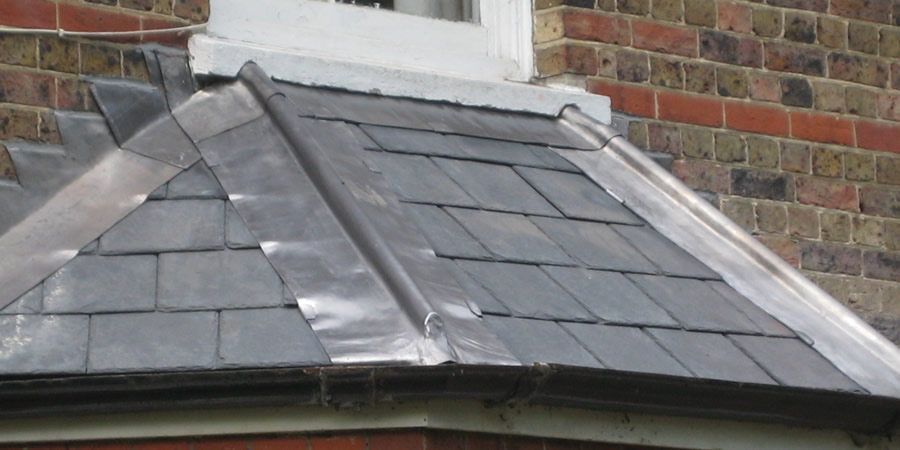Lead in construction
Contents |
[edit] What is lead?
Lead is an element that is naturally occurring throughout the environment. It is a soft, malleable, heavy metal, with a density that exceeds that of most common materials. It has a number of properties that have made it a useful construction material for hundreds of years:
- High density.
- Low melting point.
- Ductility.
- Resistance to oxidation.
- Abundance.
- Ease of extraction.
However, in the late-19th century it was discovered that lead is poisonous, and its use has been less widespread since then. Exposure can result in serious health problems such as kidney disease, anaemia and cancer.
[edit] Construction applications
Lead was used for making water pipes in the Roman Empire, and its production subsequently grew throughout South and East Asia, especially in China and India. Across Europe, lead production began to revive in the 11th and 12th centuries, where it was used for roofing and plumbing. From the 13th century, lead was used to create stained glass. More recently, lead and lead compounds were used for roofs, cornices, tank linings, electrical conduits, cladding, flashing, gutters, and parapets.
Lead was incorporated into soft solder, an alloy of lead and tin, and used for soldering tinplate and copper pipe joints. Lead-based paint inhibits the rusting and corrosion of iron and steel, and continues to be used on steel structures such as bridges, railways, lighthouses, and so on.
[edit] Health risks
Lead dust, fumes or vapour can be created when lead and items containing lead are processed, worked or recovered from scrap/waste. The body absorbs lead when it is inhaled or swallowed, but generally not through the skin. Lead that is absorbed circulates in the blood and bones where it can be stored for many years without ill health developing.
However, high lead content can cause:
- Headaches.
- Tiredness.
- Constipation.
- Nausea and stomach pains.
- Anaemia.
- Weight loss.
More serious symptoms that can develop over time include:
[edit] Working with lead
Lead can be present in the built environment, particularly in older buildings, in the paint, roofing and pipework.
Work that can produce hazardous lead dust, fume or vapour includes:
- Blast removal and burning of old lead paint.
- Stripping of old lead paint.
- Hot cutting in demolition and dismantling operations.
- Scrap-processing.
- Lead roofing.
- Lead smelting, refining, alloying and casting.
- Manufacturing leaded glass.
- Recycling lead-containing materials.
Some prevention and safety techniques that can be employed when working with lead include:
- Using substitute materials.
- Leaving lead paint in place if it is in good condition and/or covered by non-leaded paint.
- Using cold/mechanical cutting instead of hot cutting.
- Using lower temperatures without blow-lamps or gas torches.
- Use chemical paint strippers, wet abrasive paper, scrapers and infrared equipment.
- Wear appropriate respiratory protective equipment, disposable coveralls and gloves.
- Prevent the spread of dust or fumes with plastic sheeting.
- Wash and clean surfaces which may have been exposed to dust or fumes.
- Dispose of contaminated waste safely.
- Wash hands and forearms thoroughly after working with lead.
- Avoid hand-mouth/eye contact when in contaminated areas.
[edit] Types of lead
Lead is typically available as as:
Rolled lead sheet is available in a range of codes (generally codes 3-8 for construction) as defined in BS EN 12588:2006: Lead and lead alloys. Rolled lead sheet for building purposes. The code relates to the thickness of the sheet; with code 3 being 1.33 mm thick and code 8 being 3.55 mm thick.
[edit] Related articles on Designing Buildings
- Aluminium.
- Asbestos.
- Construction dust.
- Construction materials.
- COSHH.
- Deleterious materials.
- Flashing.
- Hazardous substances.
- Lead.
- Paint.
- Risk assessment.
- Soldering.
- Spangle.
- Tin.
- Types of roof.
- Volatile organic compounds.
[edit] External resources
Featured articles and news
CIOB and CORBON combine forces
To elevate professional standards in Nigeria’s construction industry.
Amendment to the GB Energy Bill welcomed by ECA
Move prevents nationally-owned energy company from investing in solar panels produced by modern slavery.
Gregor Harvie argues that AI is state-sanctioned theft of IP.
Heat pumps, vehicle chargers and heating appliances must be sold with smart functionality.
Experimental AI housing target help for councils
Experimental AI could help councils meet housing targets by digitising records.
New-style degrees set for reformed ARB accreditation
Following the ARB Tomorrow's Architects competency outcomes for Architects.
BSRIA Occupant Wellbeing survey BOW
Occupant satisfaction and wellbeing tool inc. physical environment, indoor facilities, functionality and accessibility.
Preserving, waterproofing and decorating buildings.
Many resources for visitors aswell as new features for members.
Using technology to empower communities
The Community data platform; capturing the DNA of a place and fostering participation, for better design.
Heat pump and wind turbine sound calculations for PDRs
MCS publish updated sound calculation standards for permitted development installations.
Homes England creates largest housing-led site in the North
Successful, 34 hectare land acquisition with the residential allocation now completed.
Scottish apprenticeship training proposals
General support although better accountability and transparency is sought.
The history of building regulations
A story of belated action in response to crisis.
Moisture, fire safety and emerging trends in living walls
How wet is your wall?
Current policy explained and newly published consultation by the UK and Welsh Governments.
British architecture 1919–39. Book review.
Conservation of listed prefabs in Moseley.
Energy industry calls for urgent reform.



























